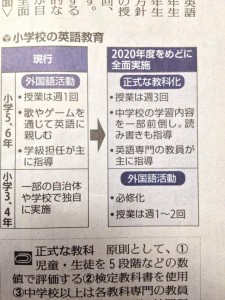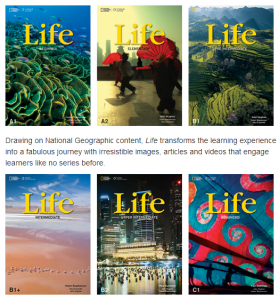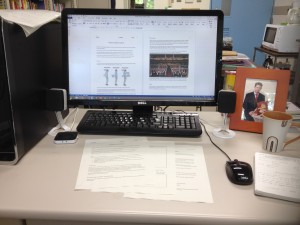conference curriculum extensive reading high school presentations university
by sendaiben
leave a comment
Step-by-step Extensive Reading Program Development
This is my workshop from the JALT national conference 2013: Step-by-step ER Program Development.
If you are interested in the topic, you can still get a free copy of our bilingual handbook for teachers here.
More thoughts on (elementary school) English
I’ve had a few interesting conversations about this in the last couple of days, so I thought it might be good to summarize some of the ideas here.
Here is a Yomiuri article (in Japanese) that summarises the proposals. Basically the government is leaning towards establishing English as a subject in elementary school years five and six. Being a subject would mean that students would receive grades, use textbooks, have three classes a week, and be taught by specialized teachers.
English (or international fun happy studies, or whatever they end up calling it) would also be introduced into years three and four as an activity: one class a week, no grades or textbooks, sounds like taught by homeroom teachers. Basically what the older kids are doing now.
The Good
- English in ES will have more legitimacy as a subject.
- Students will have more contact hours.
- The government has recognised that specialized teachers will be necessary.
- Younger students will have the chance to start with English.
The Bad
Basically nothing is bad as such in the announcement, but there are several important uncertainties:
- We don’t know how the government intends to recruit/train the ‘specialised teachers’.
- We don’t know how the curriculum will be developed.
- We don’t know what kind of materials will be available to teachers.
My Prediction
If we look at how things have turned out in the past with previous educational reforms, we don’t have much to be confident about.
I attended Cory Koby’s interesting presentation yesterday at the JALT National Conference, on the topic of the new Course of Study for Senior High School. He explained that although MEXT can issue recommendations, ultimately it is up to boards of education, schools, and individual teachers to carry them out.
I suspect that schools will not end up with experienced, English-speaking teachers for these classes. I suspect that the materials will be much the same as the ones we see now, and I suspect that the usual companies will seek to profit by offering inappropriate technological solutions.
The disconnect between policy makers and implementation can be particularly wide in Japan, and much as with previous policies (including the current ‘teach in English’ edict) I fear this will not trickle down to the chalkface.
Elementary School English (MEXT announcement)
Some big news from MEXT this week (courtesy of Kensaku Yoshida on Facebook)
Basically, from 2020 (estimated), 5-6 grade students will have English as a subject three times a week with specialist teachers. 3-4 grade students will have English activities once or twice a week.
The devil is in the details (see my recommendations here) but this looks like a step in the right direction!
language courses materials Review reviews textbooks
by sendaiben
leave a comment
Review: Life (4-skills series by Cengage)
After a long hiatus, a review. This textbook is for teenagers and adults.
Life is a 6-level, 4-skills series consisting of a student book, workbook, and teacher’s book at each level. The student book has a DVD with videos, and the teacher’s book contains two CDs with the class audio. The workbook also has a CD for listening-based homework. The series runs from Beginner (A1) to Advanced (C1).
First impression: Life is gorgeous. Cengage is really leveraging all those National Geographic photos they have access to, and it is working really well. If you are a Japan-based teacher you will probably be struck by how dense the book is -there is a lot on each page and much less white space than we are used to. Someone described it as a ‘European-style’ textbook, as opposed to ‘Asian-style’.
The Good
- This is a very attractive textbook. The design and production values are very high.
- There is a lot of content. Each book has 12 units, each unit has 6 sections. We’ve been working through one section per class so far.
- A really nice variety of topics and media (print. audio, video).
- There is a lot of variety. Reading, grammar, vocabulary, and speaking exercises on almost every page.
- The class audio is included in the teacher book. I like this idea a lot, rather than making us buy separate overpriced classroom CDs like many publishers do.
- The website actually seems to have useful materials on it 🙂
The Bad
- It’s expensive. All those production values come at a cost (EDIT: but there is a split edition I haven’t seen that incorporates half of the student book and workbook together).
- For Japanese students, it’s completely unbalanced. The grammar parts are way too easy, the reading/listening are too difficult.
- The dense page layouts can be intimidating (just a first impression problem).
Overall
I really like the series so far. We’re three weeks in and the students like it and are challenged by it, and it’s a fairly intuitive textbook from the teacher’s point of view. We’ve been using the Intermediate level with our ‘advanced’ high school student eikaiwa class, so I’m looking forward to using some of the other levels in due course. Recommended.
curriculum expectations language courses materials presentations publishing textbooks university
by sendaiben
leave a comment
Creating new teaching material
This semester I am working on a new presentation textbook for my classes here at Tohoku University (okay, so I am also hoping I will be able to sell it to a publisher eventually too), and thought it might be interesting to write a little about how that is turning out. Experienced material developers probably won’t get much out of this, but if you are just starting out like I am, or have yet to start, you might find something useful.
My desk at work. Note the all-important coffee cup and blank notebook -I find it really helpful to explore ideas on paper before starting work on the computer.
For my presentation course, I was provided with some fairly rigid constraints: too many students (one class of 32 and one of 25), too few classes (maximum of 14, more like 13 once the first one is used up for orientation), and a not-quite perfect classroom (it’s a little too small for group work). However, this is actually helpful, as it provides space in which to work. Having complete free reign paralyses me.
My project is very much a work in progress at the moment, but here are the major steps so far:
- determine the goals of the course
- decide on topics to include, and the order to teach them in
- establish a class routine
- figure out what materials to create for each class
- write the materials
- scribble over the materials in red pen after class with corrections and ideas
I have realised those four elements in bold are the foundation of a class, and getting them straight is probably 90% of the work. Now that they are done, and in great contrast to previous courses I have designed, it’s pretty easy to sit down each week and plan my classes.
Right now I am mainly trying to get the content and the activities right, and not worrying too much about design.
Has anyone successfully completed a project like this? Am I missing anything?



